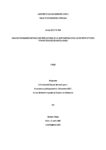Analyse pharmacocinétique des populations de la daptomycine chez les patients atteints d’infections ostéo-articulaires
Daptomycin is validated as a treatment of bone and joint infections (BJI) by the Infectious Disease Society of America. Dosage adaptation is currently exclusively adapted on the weight and the creatinine clearance. However, other factors such as sex and P-glycoprotein polymorphism, encoded by ABCB1 gene, may also greatly influence the pharmacokinetics.
Between 2013 and 2016, all patients follow in French regional reference center, treat for a BJI by daptomycin and for whom the ABCB1 polymorphism had been evaluated, were include. Population approach was used to determinate the pharmacokinetics factors, their interindividual variabilities and the weight of the parameters associated to those variabilities
Eighty-one patients (Age 60 ±18) received mean doses of 8 ±1.9mg/kg of daptomycin, in association with rifampicin in 8 patients (10%). We collect information about 200 therapeutic drug monitoring (577 measures). 30 patients had a predose concentration (Cmin) higher than the toxic threshold (Cmin ≥ 24.3 mg/L) but only of them 3 had an elevation of serum creatine kinase. Four parameters were found to be influence pharmacokinetics: daptomycin plasma clearance (CL), central volume of distribution (V1), intercompartmental clearance and peripheral volume of distribution. Female had a CL 19% lower than male (0.585 vs 0.729 L/h). CL was also linked with creatinine clearance (CLcr) (decrease of CL by 30% when CLcr decreased by 50%). V1 was influence by weight and ABCB1 polymorphism. Indeed, haplotype 3435CC-2677GG-1236CC was associated with a lower V1 (7.56 vs 10.1 L).
In our study, we demonstrated that the pharmacokinetics inter-individual variations could be explained by weight and creatinine clearance, but also greatly by sex and ABCB1 polymorphism. It would be necessary to further investigate and validate this model to propose dosage adaptation related to these covariates.



